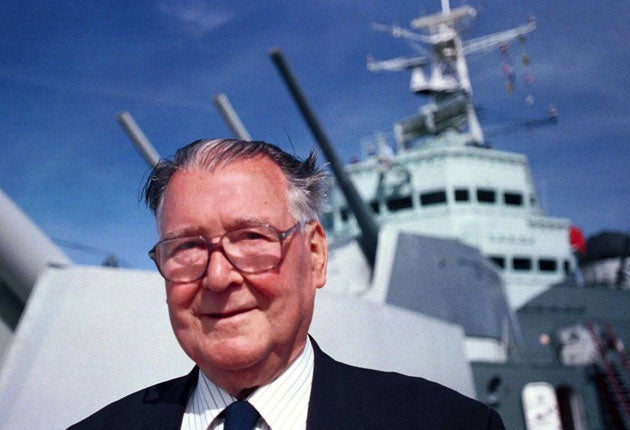Ted Briggs: Last survivor of the battleship HMS 'Hood', sunk by the 'Bismarck' in 1941

Ted Briggs was the last survivor of the battle cruiser HMS Hood, sunk by the German warship Bismarck in the North Atlantic during the Second World War. The complement of "The Mighty Hood", as she was affectionately known, was 1,421. When Briggs fought his way to the surface, he could see only two other survivors – there were no other bodies on the surface.
On the evening of 23 May 1941, Bismarck was sighted in the Denmark Strait, between Greenland and Iceland, along with Prinz Eugen. Hood, alongside HMS Prince of Wales, was sent to intercept her. What followed was several hours of cat-and-mouse. Finally, at 5.35am on 24 May, Hood spotted both German ships. Briggs, then an 18-year-old officers' messenger, later recalled what happened: "We had taken them by surprise and we fired about half a dozen salvos before she replied. But when she did, her gunnery was excellent. The third salvo hit us at the base of the main mast, which caused a fire. Then we were hit just above the compass platform, which caused some bodies to fall down. I saw one officer with no face or hands."
Still supremely confident that she could get the range she wanted, Hood moved closer – and that was when the final salvo, a single 1,700lb armour-plated shell, struck deep into the bowels of the Hood, and it hit the magazine where a hundred tons of cordite were stored. The Hood rose like a stricken animal and sank within two minutes.
Briggs was to recall: "A blinding flash swept around the outside of the compass platform. I found myself being lifted off my feet and dumped head-first on the deck." For Briggs, this was a moment of extreme terror. Since his first sighting of the mighty Hood as a boy of 12, he had always wanted to join it. Now, after two wonderful years, his home, his ship, was disintegrating. There was no order to abandon ship, but everyone was trying to get out, and to his amazement, the Flag Officer, seeing the youthful Briggs, gave way to him – an action which saved Briggs' life.
With the ship almost on its side, Briggs climbed down a ladder. As the freezing sea hit his legs, he took off his tin hat, gas mask and anti-flash gear. The ship lurched and he was sucked under – but a sudden explosive release of gas blasted him back to the surface. He recalled, "I could hear what sounded like the hissing of a hundred serpents, so I turned, and 50 yards away I could see the bows of the Hood, standing vertical in the sea."
It was an awesome sight as it sank beneath the surface. For the rest of his life, Briggs was haunted by that nightmare vision. Only two other men survived – Midshipman William Dundas, who was killed in a car crash in 1964, and the redoubtable Able Seaman Bob Tilburn, who died in 1995.
All three clung to floats, and after four hours they were picked up by the destroyer HMS Electra. Briggs took a long leave, and was told that he must not talk about the sinking; he attended the second inquiry. The loss of the Hood was a terrible shock for Britain, who thought its Navy impregnable. But the Hood had grown old. She had been launched in 1918, whereas the Bismarck had only been at sea for eight weeks and was more powerfully armed.
Briggs continued to serve in the Royal Navy and in 1955 he was commissioned. In February 1973 he retired from the Navy and settled in the south of England. In 1975, he joined the newly formed HMS Hood Association as its first president – a post he later handed over to Bob Tilburn. In a compelling television documentary in 2001, Briggs was recorded releasing the Roll of Honour plaque over the site of the Hood's last resting place.
Max Arthur
Albert Edward Pryke Briggs, seaman: born Redcar, North Riding of Yorkshire 1 March 1923; MBE 1973; twice married; died Portsmouth 4 October 2008.
Subscribe to Independent Premium to bookmark this article
Want to bookmark your favourite articles and stories to read or reference later? Start your Independent Premium subscription today.

Join our commenting forum
Join thought-provoking conversations, follow other Independent readers and see their replies